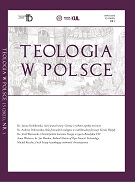Artykuł jest komentarzem do wykładu K. Bartha Der Heilige Geist und das christliche Leben. Centralną myśl stanowi teza, że nie istnieje żadna forma „kontynuacji” (Kontinuität) między duchem człowieka a Duchem Boga. Ten brak ciągłości widoczny jest w tajemnicy stworzenia – istnieje ontologiczna „nieciągłość” (Diskontinuität) między stworzeniem a Stwórcą. Podobną „nieciągłość” zauważa Barth w tajemnicy pojednania – grzech oddziela człowieka od Tego, który jest Święty. Także w tajemnicy odkupienia różnica między czasem a wiecznością tworzy diastazę między żyjącym w czasie człowiekiem a wiecznym Bogiem. Relacja między nimi może zaistnieć jedynie w wyniku cudu Bożej łaski.
SUMMARY
DIASTASE AND THE HOLY SPIRIT IN THE THOUGHT OF THE EARLY K. BARTH
The article is a commentary on K. Barth’s lecture Der Heilige Geist und das christliche Leben (The Holy Spirit and the Christian Life). Its central thought is the thesis that there is no form of ‘continuation’ (Kontinuität) between man’s spirit and the Spirit of God. This lack of continuity can be seen in the mystery of creation – there is an ontological ‘discontinuity’ (Diskontinuität) between the creation and the Creator. Barth observes the similar ‘discontinuity’ in the mystery of reconciliation – the sin separates man from That, who is Holy. Also in the mystery of redemption the difference between time and eternity creates the diastase between the man living in time and the eternal God. The relation between them can appear only as a result of the miracle of God’s grace.
Ostatnia aktualizacja: 06.02.2019, godz. 12:11 - Marcin Walczak































